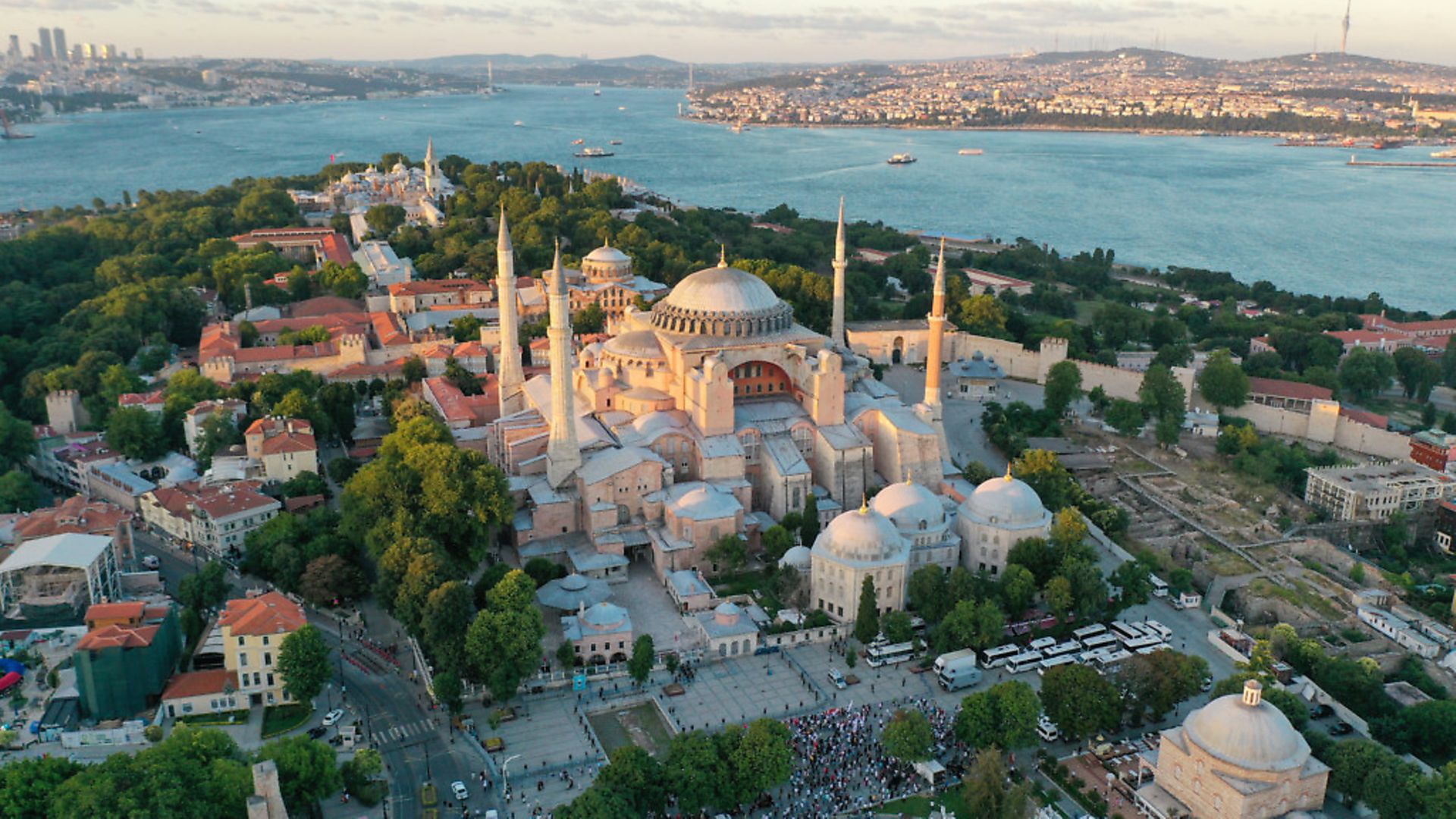
The Turkish president’s decision to convert Hagia Sophia back to a mosque could backfire on him, suggests SUNA ERDEM, as she explores the politics and history of a contested site.
One afternoon in May 1453, the man who would become known as Mehmed the Conqueror rode through streets running with blood, past a waterway where corpses ‘floated out to sea like melons’.
He finally dismounted and stepped inside the cavernous beauty of the cathedral of Holy Wisdom, where he prayed – below golden mosaics of Jesus, Mary and Orthodox saints – to Allah.
This scene, painted in detail in Philip Mansel’s book, Constantinople, City of the World’s Desire, of Sultan Mehmed II hotfooting it to the ‘mother church of eastern Christendom’ and bowing down in Muslim prayer, embodies the pivotal moment when the Islamic Ottoman empire conquered Christian Byzantium.
More than five centuries later, the great church of Hagia Sophia (from the Greek for Holy Wisdom) remains the focus of what may look like a territorial battle between two religions but is in fact a political act by a leader in trouble.
Back in the 15th century, Mehmed II refused to let his men sack Hagia Sophia and converted it into a mosque. That is how it remained until the fall of the Ottoman Empire after the First World War, when another legendary leader, Kemal Ataturk – who founded the Turkish republic in its place – turned it into a museum. It was a key modernising policy signposting Turkey’s secular, pro-Western political identity.
Now Turkey’s autocratic president, Recep Tayyip Erdogan, who styles himself as a quasi-Ottoman ruler with the stature of an Ataturk, has finally joined them in making his own mark on Hagia Sophia’s history by declaring it a mosque once more, defying international outrage and restricting access to one of the most iconic buildings in the world.
The move came after a Turkish court ruled last Friday that Ataturk’s 1934 conversion was unlawful. The decision to dismiss an act by the admired first president signals that Turkey, under a president with roots in political Islam, is prepared to diverge further from the west. Or, as Turkey’s Nobel Literature Laureate Orhan Pamuk put it: ‘Turning Haghia Sophia into a mosque again is telling the rest of the world that we are no longer secular.’
When Erdogan declared that Hagia Sophia, ‘the common inheritance of humanity’, would ‘open to worship with Friday prayers on July 24, MPs fell over themselves to express pleasure. A group of men outside the 1,483-year-old UNESCO heritage site chanted ‘Allah is Great!’ and cried.
The row over Hagia Sophia, a lucrative tourist favourite, has spanned decades, intensifying under Erdogan.
‘Hagia Sophia has long been an obsession of the Turkish right, including Islamists,’ said a Turkish source with long experience following Erdogan.
‘It plays to all their themes – the glorious conquest of Istanbul, annoying the Greeks, standing up to the west, sovereignty, galvanizing the masses and so on,’ he added. ‘Previously, power and Realpolitik ensured they came to their senses. But Erdogan has clearly run out of ideas so this is what he comes up with.’
As well as inviting censure from governments and Christian leaders worldwide, the decision has alarmed Byzantine scholars for whom the cathedral has a significance well beyond that of a place of worship.
‘Hagia Sophia is the most important building ever constructed during the 1,100-year history of the Byzantine empire, and its architecture and interior decoration have been studied extensively by specialists,’ Dame Averil Cameron, chairman of the Oxford Centre for Byzantine Research’, said.
‘It is described in many texts of the Byzantine era and was the place of endless important events,’ she continued. ‘The mosaics alone, added at different periods, tell a story of the history of Byzantium, and are absolutely central for all historians of the period.’
Cameron, former warden of Keble College, Oxford, spoke in a personal capacity, but she is one of 300 signatories of an open letter by scholars of Byzantine and Ottoman history urging that the fabric and access to the building be preserved and its artworks remain protected and visible.
‘Hagia Sophia is too beautiful a monument and too precious a historical document to serve as a pawn in regional politics,’ states the letter, signed by a multinational cast of luminaries representing institutions including universities in New York, Moscow and Istanbul to the Victoria and Albert Museum, Sotheby’s and Dumbarton Oaks. It urges Ankara to continue the responsible stewardship of successive Byzantine, Ottoman, and Turkish governments.
Turkish government spokesman Ibrahim Kalin has cited Notre Dame as a model for the conversion, with worship and tourism existing side by side. Erdogan has compared it with its neighbour, the 17th century Blue Mosque, which is also open for prayer and visitors.
But neither of the comparisons take into account the fact that, unlike the other examples, the nature of the building and the requirements of the worship within are at odds – that figurative illustrations are considered incompatible with Islam. One option put forward is for special lighting enabling the images to be hidden in darkness during prayer.
Completed in 537 AD, Hagia Sophia was built in just five years, after emperor Justinian ordered an ambitious replacement of the previous church on the site that had been burned in the Nika insurrection, when nearly half the city was destroyed.
A court official, Paul the Silentiary, described the construction with awe: ‘Before one comes to the glitter of cut mosaic, the mason, weaving together with his hands thin slabs of marble, has figured upon the walls connected arcs laden with fruit, baskets and leaves, and has represented birds perched on boughs.…Such ornament surrounds the beauteous church.’
Hagia Sophia has lost part of its dome at least three times, once in an earthquake. In 1204 it was looted and damaged during the Fourth Crusade. Under the Ottomans, four minarets were added, and huge discs of Islamic calligraphy hung inside to cover Christian illustrations. Some figures were whitewashed over, but exposed during 20th century restorations.
With its large domed roof, it became an international template for churches and mosques for centuries. In the 16th century it inspired the landmark mosques of Sinan – the ‘Michelangelo of the East’ who was the architect of Suleiman the Magnificent, the Ottomans’ most successful empire builder.
Sultans were fond of Hagia Sophia. According to Ottoman travel writer Evliya Celebi, Sultan Murad VI ’caused cages, containing a great number of singing birds, and particularly nightingales, to be hung up there, so that their sweet notes, mingled with the tones of the muezzins’ voices, filled the mosque with a harmony approaching to that of Paradise’.
It probably held fewer good memories for Sultan Mehmed IV, who was deposed after the Grand Vizier held a high council meeting in Hagia Sophia to argue for his fall.
The sight of Hagia Sophia in the hands of the Ottomans incensed many Christians abroad. The Greeks saw regaining control as central to their plans for a modern state. During the First World War, when the weak Ottoman empire was on the losing side, the reconsecration of Hagia Sophia was a hot topic as the future of Constantinople was discussed, along with expelling the Turks from Europe.
In a 1918 memo to the war cabinet in which he suggested ‘Justinian’s great Byzantine fane of St. Sophia….revert to its original dedication’, Lord Curzon wrote of the opportunity ‘of purging the earth of one of its most pestilent roots of evil’. Let us not be surprised, then, that Turks get touchy when foreigners comment on the matter today.
Former foreign minister Yasar Yakis this month demonstrated this touchiness – which sparks some of the clamour to ‘do what we like’ with Hagia Sophia – in a tirade against crusader looting, the conversion of Ottoman mosques in Greece into churches, prisons and cinemas, and the lack of official mosques in Athens when Istanbul hosts several active Orthodox Greek churches.
In recent years, Erdogan’s ruling party sped up the building of mosques and has also been turning museum-churches into mosques.
These are possible precedents for Hagia Sophia, and the message is mixed. A smaller church, the 13th century Hagia Sophia in the Black Sea city of Trabzon, had been converted and whitewashed after Mehmed II captured the city in 1461, but its frescoes were uncovered and restored.
In 2013, the main hall was rededicated as a mosque, fabric and carpeting covering up the frescoes and the stone floor. Although open, there is little so see. Sparking greater concern is the fate of a third Hagia Sophia in Vize in Thrace, which has been badly and harmfully restored.
The Church of St Savior in Chora, a small, glittering jewel of Byzantine art in Istanbul, was last year subject of a similar decision to the city’s Hagia Sophia, yet remains unchanged.
Muslims could already pray in parts of Hagia Sophia, and Koranic verses have been recited there. There’s no practical need for more holy space, since the 10,000 capacity Blue Mosque stands opposite Hagia Sophia, half empty at prayer times.
Erdogan, who began his leadership as an internationally popular, self-professed ‘Muslim democrat’ 18 years ago, has alienated many by his slide into authoritarianism, rows over the rule of law, a belligerent foreign policy, and harsh crackdowns after mass pubic protests in 2013 and a coup attempt in 2016.
His unorthodox economic policy – now run by his son-in-law – has created an exodus of foreign money. Unemployment is rife. Covid-19 will make things worse.
His leadership has been based on being an underdog – imprisoned for reading a poem, he was supported by liberals angry at years of military domination of politics, as well as religious Turks fed up with being discriminated against by secular officialdom. But you can only play the underdog for so long, especially if you have spent the last few years locking up opponents.
Although Erdogan won a knife-edge referendum in 2017 to create a super-presidency for himself, he knows his support is waning, as evidenced by his panicked decision to rerun Istanbul’s mayoral election last year and lose again, casting doubt over his ambition to preside over the centenary of the republic in 2023.
When it comes to Hagia Sophia, there has also been a seam of criticism at home, even among conservative figures and religious experts, some of whom fear the image of Turkey will be damaged abroad, with no discernible benefit at home.
Having played to the crowd, Erdogan will have to hope that the crowd pays back. His weakening position – saved only by the lack of strong opposition – has led him to irrational choices that may backfire.
Whatever happens, when Turkey celebrates its centenary, Hagia Sophia will still be there – after all, it has survived one and a half millennia of plunder, fires, earthquakes, occupation and war. Whether Erdogan will be is quite another matter.










